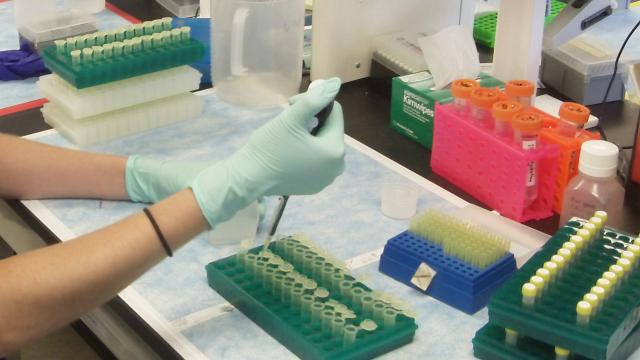Using a modified version of CRISPR, a team of geneticists has successfully triggered 13,200 genetic changes to a single human cell. That’s a new record, by a long shot. This sweeping new editing process could eventually be used to strip DNA of useless or dangerous genetic information — or create entirely new kinds of life.
New research uploaded to the preprint bioRxiv server describes the achievement, in which a Harvard University team led by George Church edited the living crap out of a single human cell to the tune of 13,200 total modifications. Incredibly, the cell survived.
The previous record for bulk edits made to a single cell was set in 2017, when Church and his colleagues knocked out 62 copies of a retrovirus found in pig genomes. The new achievement is thus “three orders of magnitude greater” than the previous standard, the authors wrote in their paper.
The purpose of such work is to enable the large-scale editing of genomes, which would allow for dramatic redesigns of existing genomes, or the flushing out of troves of unwanted, deleterious genetic information from DNA, including retroviruses or redundant genes. Large-scale editing would subsequently enable the engineering of new species, or create clean, foundational genomes that have been stripped down to their most basic elements. And as Antonio Regalado reports in MIT Technology Review:
Church says his eventual objective is to create supplies of human organs or tissues whose genomes are revised so they are immune to all viruses. That process, called recoding, would involve about 9,811 precise genetic modifications, according to the team. Church says the lab has started the process of recoding supplies of his own cells in the lab. “These are intended to be safe…and universal stem cells,” he says.
For the new study, Church and his colleagues set about the task of editing and disabling a problematic type of transposon known as LINE-1. Transposons are often referred to as “jumping genes” because they consist of DNA sequences that can leap from one location on a genome to another. Transposons are ubiquitous in mammalian DNA, including in humans. Slightly less than half of the entire human genome consists of transposons, yet their utility and function are still a matter of dispute.
LINE-1 transposons comprise around 17 per cent of the human genome, and they’ve been associated with a number of health issues, including gene disruption, neurological diseases, and ageing. LINE-1 transposons have collected too many mutations over time and have degraded such that they’re no longer coding for anything useful. Scientists would very much like to find safe and effective ways of mitigating the proliferation of LINE-1 in the human genome, hence the interest in large-scale genetic editing.
Initially, Church’s team used the conventional version of the CRISPR gene-editing tool to hack away at the LINE-1 sequences—hack being the key word. CRISPR doesn’t usually cause problems when it takes a chunk or two from a DNA strand, but as the researchers found out here, it wreaks tremendous havoc when it takes chunks from hundreds of different sites. As noted in the new study, the first efforts to make LINE-1 edits resulted in the complete annihilation of the cells, so it was back to the drawing board.
For the second effort, the team used a modified version of CRISPR known as a base editor. Instead of cutting DNA, the base editor swaps out genetic letters, replacing G with an A, for example. With no cuts to the DNA required, and with no catastrophic effects to the overall structure of the double helix, the researchers were able to edit thousands of genes without the associated cellular death observed earlier.
The 13,200 edits represent about half of the 26,000 active LINE transposons in a human cell, but Church told New Scientist, “We hope, in the future, to knock-out 100 per cent of active LINE elements.”
It’s an impressive achievement, but there are still plenty of unknowns to consider.
“More in-depth studies will be necessary, however, to assess the impact of this massive editing on normal cell processes, since collateral damage may occur,” wrote the authors in the study. Indeed, the intense number of tweaks could have introduced a significant number of unintentional mutations, which aren’t immediately obvious given how many edits were made.
The researchers admitted this presents a formidable challenge, “therefore, strong biological controls as well as new experimental and bioinformatics [approaches] will be needed to overcome such a challenge,” they wrote.
It’ll likely be quite some time before we see this new technology applied at the clinical level, but as the new research makes clear, we’re getting increasingly better and more capable of editing genes—even when when making thousands of edits at a time.
